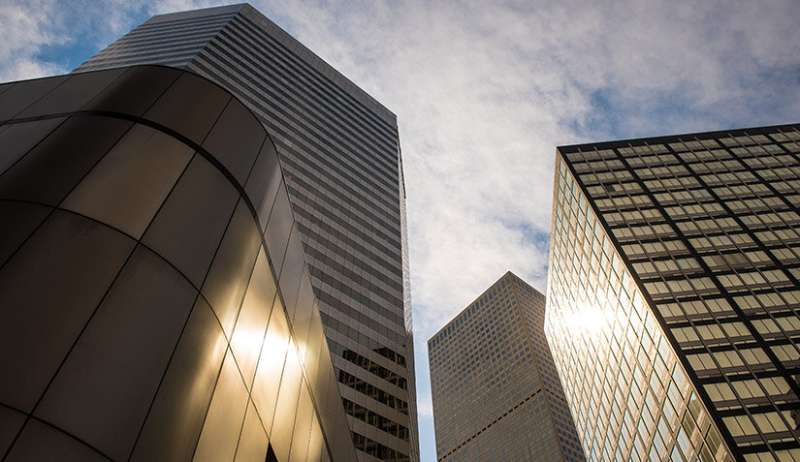
The use of thermochromic windows in office buildings improves energy efficiency across all climate zones in the United States by modulating the temperature inside, leading to a massive savings, according to a research effort led by the U.S. Department of Energy’s National Renewable Energy Laboratory (NREL).
The thermochromic windows based on the use of perovskite materials to absorb energy from the sun shift from transparent to a visibly absorbing or reflecting state. The technology mitigates heating loads in warm climates and cooling loads in colder regions.
Lance Wheeler, principal investigator on the project, said switching to thermochromic windows saves a significant amount of energy annually, with the main source of savings coming from requiring less heating energy for highly glazed office buildings in cold or seasonal climates. If all workers in the simulated office building drove an electric vehicle the distance of an average American commute, then the annual energy could be used to fully charge every worker’s car every day throughout the year.
The findings are detailed in the paper “Thermochromic Halide Perovskite Windows with Ideal Transition Temperatures,” which appears in the journal Advanced Energy Materials. His co-authors from NREL are Bryan Rosales, Janghyun Kim, Kevin Prince, Mirzo Mirzokarimov, Tom Daligault, Adam Duell, Colin Wolden, and Laura Schelhas. Other co-authors are from Colorado School of Mines, University of Wisconsin–Stout, and Swift Solar.
The research, which relied on modeling software Wheeler helped develop called “PVwindow,” suggests adding a thermochromic laminate onto a single-pane or even double-pane window will yield significant savings.
Buildings account for about 40% of all primary energy consumption in the United States, with heating making up the largest contributor. Coating technology revolutionized window energy efficiency beginning in the 1980s by selectively absorbing or reflecting infrared light but allowing light in the visible portion of the solar spectrum to pass through the glass. However, slightly more than half of the sun’s energy occurs in the visible wavelengths, so more energy is required to heat or cool buildings with significant glass facades.
The researchers used as their model building a 12-story structure with a window-to-wall ratio of 95%. They simulated energy use in the building in 15-minute intervals for a year in eight climate zones across the country, covering Hawaii, Arizona, California, Colorado, New York, Wisconsin, Minnesota, and Alaska. They determined:
- Thermochromic double-pane windows improved building energy efficiency over double-pane windows in each zone.
- Energy savings were greater in colder regions.
- Thermochromic double-pane windows outperformed even triple-pane windows in the hottest climate zones.
The researchers noted that in colder climates triple-pane windows provided more energy savings than the thermochromic double-pane windows, but adding a thermochromic laminate to create a triple-pane window provided the most annual energy savings compared to the highest efficiency double-pane windows.
The thermochromic windows are triggered by temperature, and the researchers calculated the ideal transition temperature falls in the range of 20–27.5 degrees Celsius (68–81.5 degrees Fahrenheit).
“If the transition temperature is too high, then the window may not save energy, and buildings are better off with static windows,” Wheeler said. “It is interesting that this range is valid across many different climates, from northern Minnesota to southern California. This is because dynamic windows reduce solar heat gain in the summers to save air conditioning, and they also increase solar heat gain when heat is needed in winters.”
The researchers coupled the modeling with experimental work and demonstrated a perovskite film sandwiched between two layers of glass. The thermochromic switching was proved durable for 200 cycles.
“We were able to significantly reduce the transition temperature in the lab to match the predicted ideal temperature,” Wheeler said. “The work shows off the many areas of expertise at NREL and the power of collaboration between materials science and building energy science.”
More information:
Bryan A. Rosales et al, Thermochromic Halide Perovksite Windows with Ideal Transition Temperatures, Advanced Energy Materials (2023). DOI: 10.1002/aenm.202203331
Citation:
Perovskite-based thermochromic windows reduce energy load and carbon emission in buildings (2023, February 10)
retrieved 10 February 2023
from https://techxplore.com/news/2023-02-perovskite-based-thermochromic-windows-energy-carbon.html
This document is subject to copyright. Apart from any fair dealing for the purpose of private study or research, no
part may be reproduced without the written permission. The content is provided for information purposes only.
Stay connected with us on social media platform for instant update click here to join our Twitter, & Facebook
We are now on Telegram. Click here to join our channel (@TechiUpdate) and stay updated with the latest Technology headlines.
For all the latest Technology News Click Here
For the latest news and updates, follow us on Google News.
